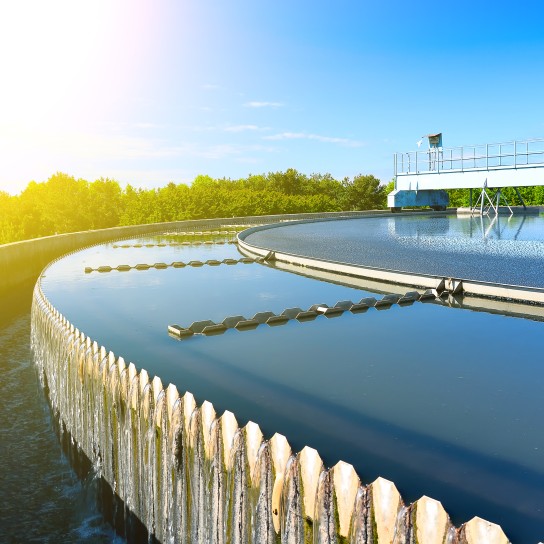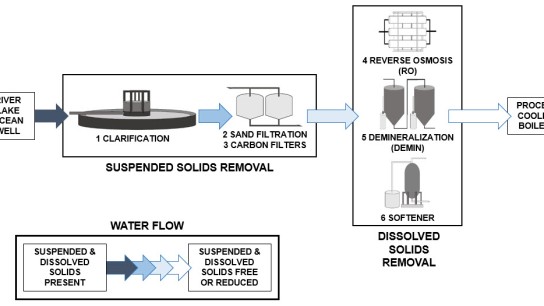Water Pretreatment

What is water pretreatment?
Water is present in many forms on the earth including rivers, lakes, oceans, and wells. Often this water needs to be treated before it can be used by industry. Suspended and dissolved solids must be removed to prevent scale, deposit, corrosion, plugging, poor product quality, and numerous other potential problems. Pretreatment is the process used to remove any harmful components from water.
Methods to remove dissolved materials
Scale is caused by dissolved materials in water precipitating and attaching onto heat transfer surfaces, which reduce heat transfer and restrict water flow. There are several methods to remove dissolved materials from water including:
- Hot and Cold Lime Softening
- Zeolite Softening
- Demineralization
- Reverse Osmosis
- Evaporation

Quality determines the removal method
The quality of water needed for steam generation or production will dictate the method needed for dissolved solids removal. Softening only removes hardness (calcium and magnesium) where demineralization, reverse osmosis, and evaporation will remove all dissolved materials. Hot and cold lime softening is utilized for clarification. Zeolite softening and demineralization use resins. Reverse osmosis uses membrane technology. Evaporation produces and condenses steam to generate pure water.
Mechanical dearation is the process that removes oxygen from water to reduce a water’s tendency to corrode. Water is heated driving off oxygen, and chemical oxygen scavengers are also fed to remove trace oxygen not removed by mechanical dearation.
| Hot and cold lime softening | Zeolite softening | Demineralization | Reverse osmosis | Evaporation | |
|---|---|---|---|---|---|
| Removes hardness only | X | X | |||
| Removes all dissolved materials | X | X | X | ||
| Clarification | X | ||||
| Resins | X | X | |||
| Membrane technology | X | ||||
| Produces and condenses steam | X |

Pretreatment process for industrial water
These are typical pretreatment equipment and applications. Note not all will be present, and these processes may exist alone or in different combinations.
Clarification and flotation (and/or filtration) are used to remove solids from the water. Surface waters from streams, lakes, or oceans contain fine dirt and biological particles, which can settle out causing deposits. Deposits can restrict flows and reduce heat transfer. Coagulation and flocculation increase the size of these small particles. These larger particles can now be removed through clarification, flotation, or filtrations.
1 Clarification: removes suspended solids
2 Sand Filtration: removes fine suspended solids
3 Carbon Filtration: removes organic materials
4 Reverse Osmosis: removes all dissolved materials
5 Demineralization: removes cations and anions
6 Softener: removes hardness
| Product | Suspended Solids Removal | Dissolved Solids Removal | |||||
|---|---|---|---|---|---|---|---|
| 1 Clarification | 2 Sand Filtration | 3 Carbon Filtration | 4 Reverse Osmosis | 5 Deminerialization | 6 Softener | ||
| Activated Carbon | X | ||||||
| Antifoams | X | X | X | ||||
| Antiscalants | X | X | X | ||||
| Biocides | X | X | X | ||||
| Brennfloc | X | X | |||||
| Brennsperse | X | X | |||||
| Carbon | X | ||||||
| Caustic | X | X | X | ||||
| Chlorine | X | X | |||||
| Citric Acid | X | ||||||
| Corrosion Inhibitors | X | X | |||||
| Defoamers | X | X | |||||
| Filtration Media | X | X | |||||
| Flocculants | X | X | |||||
| Hydrochloric Acid | X | X | |||||
| Inorganic Coagulants | X | ||||||
| Ion Exchange Resins | X | X | |||||
| Lime | X | X | |||||
| Membrane Chemicals and Cleaners | X | ||||||
| Organic Coagulants | X | X | |||||
| Permanganates | X | ||||||
| pH Adjusters | X | X | |||||
| Resins | X | X | |||||
| Salt | X | ||||||
| Scale Inhibitors | X | X | X | ||||
| Sodium & Potassium Permanagantes | X | ||||||
| Sodium Hydroxide | X | ||||||
| Sulfuric Acid | X | X | |||||
We're here to help
Our Water Treatment Team is here to solve your latest challenge and assist in product selection for your specific application.
Start the conversation